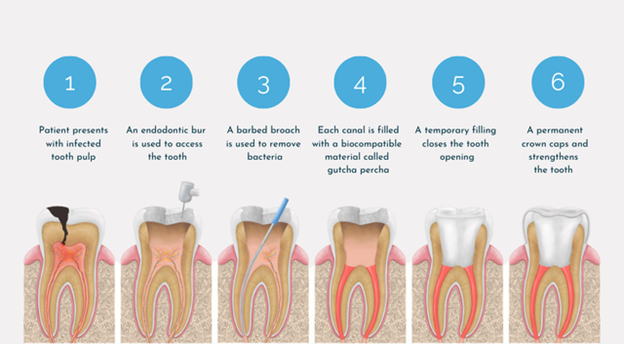Oral health problems aren’t just minor inconveniences, especially those affecting the inner pulp of the tooth, deeply impacting daily comfort, focus, and even nutrition.
And this can be very concerning. Consider this…
Across the globe, dental decay and pulp-related issues are among the most common reasons for dental pain. According to the World Health Organization, nearly 3.5 billion people suffer from oral diseases, with dental caries leading the list. In India alone, studies reveal that more than 60% of adults experience tooth decay at some point, and untreated pulp infections often progress to severe pain or abscess formation.
Dr. Manjul Jain, a meticulous Dentist and Implantologist in Andheri, shares:
“Tooth pain isn’t just about discomfort — it’s the body’s alarm system signaling that something’s wrong deep inside the tooth structure. Timely intervention, especially with root canal therapy, can save a tooth that might otherwise be lost. The key lies in understanding the nature of the pain and seeking help before it escalates.”
But before understanding how treatment helps, let’s explore what makes acute pain different from chronic pain — and why that distinction matters.
Acute vs Chronic Pain
Pain isn’t one-size-fits-all. The body experiences and reacts to it in unique ways depending on duration, intensity, and underlying cause.
Acute pain is the body’s immediate response to injury or infection. It appears suddenly — sharp, intense, and often accompanied by swelling or sensitivity. This is your tooth’s way of waving a red flag.

Chronic pain, on the other hand, lingers long after the initial cause has been treated or ignored. It can be dull, recurring, and emotionally draining, sometimes indicating deeper nerve damage or untreated infection.

Recognizing these differences helps dentists determine whether a root canal treatment in acute and chronic pain is needed.
Dr. Manjul Jain, a compassionate dental surgeon in Andheri, explains:
“Acute pain acts as an emergency alert, but chronic pain is the body’s quiet cry for help. Both deserve attention — and when linked to the tooth’s inner pulp, a root canal can often be the definitive solution.”
So, what role does a root canal play when that sharp pain strikes suddenly? Let’s dive deeper.
How Root Canal Treatment Helps Manage Acute Pain
Root canal therapy targets the core of the problem — the infected pulp. The pulp contains nerves and blood vessels that, when inflamed, cause intense, often unbearable pain.
Here’s how it works to relieve acute pain:
Pain Source Removal: The dentist removes the infected or dead pulp, instantly eliminating the nerve trigger.
Cleaning and Disinfection: The inner canal is cleaned thoroughly to remove bacteria and debris.
Sealing the Canal: The tooth is filled and sealed with a biocompatible material, preventing reinfection.
Restoration: Finally, a crown or filling restores strength and aesthetics.
This process doesn’t just stop the pain — it preserves the tooth’s natural structure.
Dr. Manjul Jain, a skilled endodontic practitioner in Andheri, notes:
“Pain relief begins the moment we remove the infection. Many patients are surprised that the procedure itself is virtually painless, especially with modern anesthetic techniques and precision equipment.”
Next, let’s look at how to recognize when it’s time to act.
Signs You May Need a Root Canal for Pain Relief
Tooth pain often tells a story — one that shouldn’t be ignored. Here are common signs that you may need root canal therapy:
Continuous or pulsating pain that worsens when chewing
Sensitivity to hot or cold that lingers even after the stimulus is removed
Swelling or tenderness, especially around the gums or jawline
Darkening of the tooth which is a sign that the pulp inside may be dying
Pimple-like bump on gums indicating abscess formation due to infection
If you notice these symptoms, it’s crucial to seek professional diagnosis. Ignoring them can turn a treatable infection into a complex dental issue.
Ever wondered what actually happens during a root canal procedure? Let’s break it down step by step.
Root Canal Treatment Process

Understanding the procedure can ease anxiety and clarify expectations.
Examination and X-ray: The dentist assesses the extent of infection using digital imaging.
Anesthesia: Local anesthesia ensures complete comfort during treatment.
Access Opening: A small opening is made to reach the infected pulp.
Cleaning and Shaping: Specialized instruments remove the infected tissue and shape the canals.
Filling and Sealing: Canals are filled with gutta-percha and sealed to prevent bacteria from re-entering.
Restoration: The tooth is capped with a crown for protection and aesthetics.
Dr. Manjul Jain, an experienced restorative dentist in Andheri, emphasizes:
“Each step aims to ensure pain relief, infection control, and long-term stability. And with advanced technology, root canal treatment today is highly precise. Patients often resume normal activities the same day — a far cry from the outdated fear associated with the procedure.”
Curious about what to expect from your treatment? Speak to a dental specialist for clarity, reassurance, and a personalized approach.
Once the infection is treated, the next question arises — what benefits can you expect in the long run?
Benefits of Root Canal Treatment for Pain Management
A root canal offers much more than immediate pain relief. Here’s what makes it a preferred choice for both acute and chronic dental pain:
- Avoids extraction and maintains your natural bite
- Prevents bacteria from affecting surrounding tissues
- Restores function so you can chew and smile confidently again
- Maintains your tooth’s appearance with crowns that match natural color
- Once treated properly, pain rarely returns
In fact, according to research published in the Journal of Endodontics, success rates for root canal therapy exceed 90%, making it one of the most reliable dental procedures worldwide.
Of course, the healing process doesn’t end when the procedure does. Here’s what to know about recovery.
Post-Root Canal Care: Managing Pain and Discomfort

Aftercare plays a vital role in ensuring long-lasting results. Here are some helpful steps:
Follow Medication Instructions: Take prescribed antibiotics and painkillers as directed.
Avoid Hard Foods Initially: Stick to soft foods to protect the treated tooth.
Maintain Oral Hygiene: Brush and floss gently around the area.
Attend Follow-up Visits: Allows your dentist to check healing and crown fit.
Mild tenderness for a few days is normal and fades quickly. However, persistent pain or swelling should be promptly addressed.
Conclusion
Root canal treatment in acute and chronic pain offers more than just relief — it restores function, prevents complications, and helps retain your natural smile. With timely intervention, advanced techniques, and expert care, what once felt like a daunting procedure now brings predictable, lasting comfort.
Still have questions about the treatment? Let’s clear them up with some commonly asked queries.
FAQs
1. Is root canal treatment painful?
Modern root canal procedures are performed under local anesthesia, ensuring a virtually painless experience. Any post-treatment tenderness is manageable with mild pain relief.
2. How long does the procedure take?
Most treatments are completed in one or two sessions, depending on the tooth’s condition and infection severity.
3. Can a root canal fail?
Although rare, reinfection can occur if the tooth isn’t sealed properly. Regular dental visits and good oral hygiene significantly reduce this risk.
4. How do I know if my tooth pain needs a root canal or just a filling?
A dentist can determine this through clinical examination and X-rays. Persistent pain, swelling, or discoloration often point toward pulp involvement.
5. How long will my treated tooth last?
With proper restoration and care, a root canal-treated tooth can last a lifetime.
References:
https://www.aae.org/patients/root-canal-treatment/what-is-a-root-canal/
https://my.clevelandclinic.org/health/diseases/10957-toothache
Disclaimer: The information shared in this content is for educational purposes only and not for promotional use.

